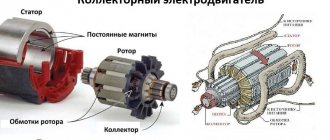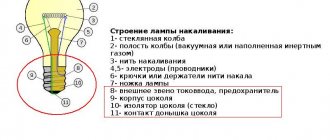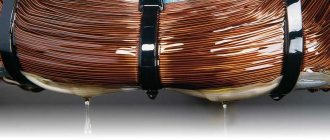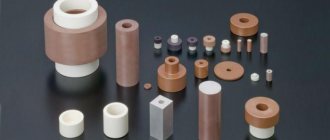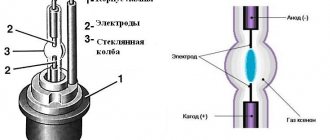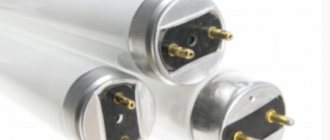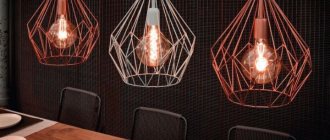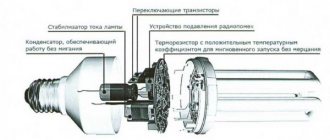Gas discharge lamps are a modern light source that emits light energy in the range visible to the human eye. Basically, a gas-discharge light bulb has a glass bulb into which gas or metal vapor is pumped under pressure. In addition, the structure of the product contains electrodes that are located at the ends of the glass flask.
Lamp structure
Design and principle of operation of lamps
According to the history of the fluorescent lamp, the first gas-discharge type lighting device was designed in 1856 by G. Geisler. The design of the devices has been improved. Fluorescent lamps came into mass commercial use at the end of the 30s of the 20th century.
The design refers to gas-discharge lighting sources, constructed using a glass tube, which is sealed on both sides. From the inside, a layer of a special substance (luminophor) is applied to the surface of the lamp. The device emits diffuse light after connecting to a power source. The inside of the flask is filled with argon.
The luminescent device includes:
- cathodes protected by an emitter layer;
- output pins;
- end panel;
- tubes for removing inert gas;
- mercury;
- stamped glass leg, supplemented with electrical inputs, etc.
The operating principle is based on the occurrence of an electric discharge between the electrodes after connecting to the electrical network. After the discharge interacts with inert gases and mercury vapor, ultraviolet radiation appears, affecting the phosphor, which converts the energy into light radiation. To adjust the shades of mercury-containing devices, phosphors with different chemical components are used.
The arc discharge in the bulb is created by an oxide self-heating cathode, which is exposed to electricity. To turn on DRL and LD lamps, the cathodes are heated by passing a current discharge. Cold cathode devices are triggered by ion exposure in a high voltage glow discharge.
To function, fluorescent devices require an additional unit (ballast), which provides operation of the throttle and starter. The ballast regulates the discharge strength and is available in 2 types (electromagnetic and electronic).
Electromagnetic ballast is mechanical. The device is a budget option; the device may make noise during operation.
Electronic components are more expensive, operate silently, turn on the system quickly, and are compact.
Review
Gas discharge lamps are a modern light source that emits light energy in the range visible to the human eye. Basically, a gas-discharge light bulb has a glass bulb into which gas or metal vapor is pumped under pressure. In addition, the structure of the product contains electrodes that are located at the ends of the glass flask.
Lamp structure
The principle of operation of the light bulb is based precisely on this structure, since the entire system is activated when an electric discharge passes through the bulb. The main electrode is located in the central part of the flask. A current-limiting resistor is installed under it. Thanks to this design, a glow is formed in the flask when an electric discharge passes through it. In addition to the bulb and electrodes, the product also contains a base, thanks to which it can be screwed into various lamps to create home or street lighting. Note! Most often, gas-discharge light bulbs are found in street lighting systems. They are often screwed into lights, cars, etc. Gas discharge lamps are special devices that are capable of creating a glow using an electrical discharge.
Types of gas discharge lamps.
According to pressure they are distinguished:
- GRL low pressure
- High pressure gas valve
Low pressure gas discharge lamps.
- Fluorescent lamps (FL) - designed for lighting. They are a tube coated on the inside with a phosphor layer. A high voltage pulse (usually six hundred volts or more) is applied to the electrodes. The electrodes heat up and a glow discharge occurs between them. Under the influence of the discharge, the phosphor begins to emit light. What we see is the glow of the phosphor, and not the glow discharge itself. They operate at low pressure.
- Compact fluorescent lamps (CFLs) are fundamentally no different from LLs. The only difference is in the size and shape of the flask. The board with the electronics for launching is usually built into the base itself. Everything is aimed at miniaturization.
The display backlight lamps also have no fundamental differences. Powered by an inverter.
- Induction lamps. This type of illuminator does not have any electrodes in its bulb. The flask is traditionally filled with an inert gas (argon) and mercury vapor, and the walls are covered with a layer of phosphor. Gas ionization occurs under the action of a high-frequency (from 25 kHz) alternating magnetic field. The generator itself and the gas flask can form one whole device, but there are also options for spaced manufacturing.
High pressure gas discharge lamps.
There are also high pressure devices. The pressure inside the flask exceeds atmospheric pressure.
- Mercury arc lamps (abbreviated as mercury arc lamps) were previously used for outdoor street lighting. Nowadays they are used less and less. They are being replaced by metal halide and sodium light sources. The reason is low efficiency.
Appearance of the DRL lamp
- Mercury arc lamps with iodides (MAI) contain a burner in the form of a fused quartz glass tube. It contains electrodes. The burner itself is filled with argon, an inert gas containing impurities of mercury and rare earth metal iodides. May contain cesium. The burner itself is placed inside a heat-resistant glass flask. The air has been pumped out of the flask; the burner is practically in a vacuum. More modern ones are equipped with a ceramic burner - it does not darken. Used to illuminate large areas. Typical powers range from 250 to 3500 watts.
- Tubular sodium arc lamps (HSA) have twice the light output compared to DRLs at the same power consumption. This variety is intended for street lighting. The burner contains an inert gas - xenon and mercury and sodium vapor. This lamp can be immediately recognized by its glow - the light has an orange-yellow or golden hue. They are distinguished by a rather long transition time to the off state (about 10 minutes).
- Arc xenon tubular light sources are characterized by bright white light, spectrally close to daylight. The power of the lamps can reach 18 kW. Modern versions are made of quartz glass. The pressure can reach 25 Atm. The electrodes are made of tungsten doped with thorium. Sometimes sapphire glass is used. This solution ensures the predominance of ultraviolet in the spectrum.
The luminous flux is created by the plasma near the negative electrode. If the vapor contains mercury, the glow occurs near the anode and cathode. Flashes also belong to this type. A typical example is IFK-120. They can be identified by an additional third electrode. Due to their spectrum, they are excellent for photography.
- Metal halide gas discharge lamps (MHDLs) are characterized by compactness, power and efficiency. Often used in lighting devices. Structurally, they are a burner placed in a vacuum flask. The burner is made of ceramic or quartz glass and filled with mercury vapor and metal halides. This is necessary to adjust the spectrum. The light is emitted by the plasma between the electrodes in the torch. Power can reach 3.5 kW. Depending on the impurities in mercury vapor, different colors of the light flux are possible. They have good light output. The service life can reach 12 thousand hours. At the same time, it has good color rendition. It takes a long time to reach operating mode – about 10 minutes.
History of the development of electrostatic ionization of gases
It is generally accepted that the year of birth of gas-discharge lamps is 1675. One night, the French scientist Jean-Felix Picard noticed the glow of a mercury barometer when he was moving it from the observatory to the port of St. Michael. In order for readers to imagine the phenomenon, it is necessary to take into account the design features. A mercury barometer has a tube sealed at the end. In addition there is a bowl. Both objects are filled with metallic mercury.
To determine the pressure, the tube is sharply turned over and lowered into the bowl. Then the mercury flows down under the influence of gravity, forming a vacuum above itself. As a result, the sealed end of the tube remains hollow, and the extent of the empty space depends on the atmospheric pressure, which, acting on the mercury in the bowl, is designed to balance the force of gravity.
Picard barometer
When transporting the barometer, Picard was in a hurry and shook the device violently. As a result, the glass was electrified by friction with mercury, and the static charge caused the ionization of metal vapors. The process was greatly facilitated thanks to the created vacuum. Mercury vapor is still used today in certain gas-discharge light sources. For example, the ultraviolet component of the glow activates the phosphor of a fluorescent lamp.
Picard could not explain the discovered phenomenon, but immediately reported what had happened to scientific circles. Later, the famous Swiss mathematician Johann Bernoulli began studying it. The task was also too much for him, but this learned man actively practiced the experiment with luminescence and gave a presentation to the French Academy of Sciences. In 1700, at a demonstration, the phenomenon was seen by an English mechanic and part-time scientist, Francis Hawksby. On the basis of the Royal Scientific Society of Britain, Hawksby begins to actively conduct experiments.
Hoxby based his decisive experiment on Guericke's model of an electrostatic generator (1660). According to the descriptions, the machine was a solid-sized ball of sulfur rotating on an iron rod. By friction against the operator's palm, the object acquired a significant charge during rotation. Hawksby's further train of thought is clear. Guericke's instructions included a proposal to pour sulfur into a glass ball and then break it. The English scientist missed this step. Unfortunately, it is unknown whether early works (for example, Gilbert's treatise of 1600) had any idea about the electrification of glass, but Hawksby put forward a corresponding assumption.
Guericke electrostatic generator model
As a result, the experimental setup contained, instead of a sulfur ball, a glass ball with drops of mercury at the bottom, and a vacuum was created inside as much as possible. When the sphere was rotated on an iron rod and electrified by friction with the palms, a glow was observed to read a book in close proximity. In 1705, the English Scientific Society demonstrated the first gas-discharge lamp. The correct explanation was provided that mercury vapor was involved in the discovered phenomenon. Then the progress of work froze for a century. There was no practical application for the newly discovered phenomenon.
Advantages and disadvantages of gas discharge lamps.
pros
- Long useful life. On average 8000 hours.
- The spectral characteristics are different. This makes it possible to choose a light source for any need.
- High power.
Minuses
- It is mandatory to have additional elements in the circuit - ballasts.
- High cost due to technological difficulties in manufacturing.
- A stroboscopic effect is possible. Sensitive to temperature and power supply conditions.
- DRL ozonizes the air.
- Some types of GRL require a long time to start.
- Difficulties with disposal due to the mercury contained.
Design
The design includes the following elements:
- glass container;
- threaded base;
- mercury-quartz burner filled with argon. Additionally, a drop of mercury is added;
- main cathodes;
- additional electrodes;
- additional carbon resistor.
Helpful information! The purpose of the additional electrodes is to facilitate lighting of the lamp. They are also responsible for stable operation.
The elements are discussed in more detail below:
- base It receives electricity from the network as a result of contact of the current-carrying parts of the lamp with the contacts of the lamp socket. As a result, electricity is transferred to the burner electrodes;
- quartz burner. It looks like a flask with two electrodes on each side (two are main, two are additional). The burner is filled with argon and a drop of mercury;
- glass flask. This is the outer part of the light bulb. Inside there is a burner with connected electrical conductors coming from the contact base. To pump nitrogen into the flask, all the air is first pumped out of it.
You may be interested in Features of light bulb sockets
The first models of DRL lamps had only two electrodes. Such lamps were more difficult to light - an additional starting device was required. The modern, throttle version is equipped with four electrodes.
Device
Marking
The marking designation of fluorescent lamps is indicated on the box and contains information about the company, power, base design, period of operation, shade of glow, etc.
According to the decoding of the index, the first letter of the marking of luminescent type devices is L. Subsequent letters indicate the color of the device’s radiation shade (daylight, white, cool white tone, ultraviolet radiation, etc.). The code value will include the characters D, B, UV, etc.
Design features on the markings are indicated by the corresponding letters:
- u-shaped fluorescent lamps (U);
- ring-shaped products (K);
- reflex type devices (R);
- quick start lamps (B).
In luminescent devices, the luminescence indicators are also displayed on the marking; the unit of measurement is Kelvin (K). The temperature indicator of 2700 K corresponds in hue to the radiation of an incandescent lamp. The 6500 K marking indicates a cold, snow-white tone.
The power of devices is marked with a number and unit of measurement - W. Standard indicators are represented by devices from 18 to 80 W.
The label also identifies the lamps according to characteristics such as length, diameter and bulb shape.
The diameter of the bulb on the lamp is fixed by the letter “T” with a code designation. The device designated by code T8 has a diameter of 26 mm, T12 - 38 mm, etc.
Markings of devices by base type contain the letters E, G and a digital code. The designation for the miniature form of the threaded base is E14. The middle threaded base has code E27. The plug-in base for decorative structures and chandeliers is marked with the G9 symbol. U-shaped devices are designated by the symbol G23, double u-shaped devices by G24, etc.
Answers to frequently asked questions
Buyers often ask questions that interest them. This is due to the lack of complete information on the packaging.
Service life, cost
An incandescent lamp is affected by many factors that contribute to shortening its life.
Recently, the quality of light bulbs produced has dropped. Often the defect is noticeable immediately. Therefore, most buyers switched to purchasing goods from foreign manufacturers.
Often a decrease in operating time occurs due to high voltage in the network. In this case, the filament overheats, it decreases in thickness, and the bulb begins to darken. The spiral breaks. If the voltage deviates by just one percent, the lamp life is reduced by 14 percent.
The cost of a light bulb depends on the type, power, and manufacturer. It ranges from 7 rubles to 100 rubles (for home consumption).
How to increase service life
There are several ways to increase the life of a light bulb:
- Dimmer installation. This simple device can extend its service life several times. To do this, after connection, the percentage of lighting is adjusted. When lighting storerooms, entrances, etc., it is enough to set the lamp performance to 75 percent.
- Since failure is often caused by voltage surges, it is enough to install a stabilizer.
What gas is in the lamp
The product flasks cannot contain air or any gas. There should only be inert gas (xenon, krypton, argon). This is due to the fact that the temperature of the coil heats up to more than 2000 degrees.
At these temperatures, the tungsten filament will react with all gases except inert ones. Helium and neon are expensive, so they are not used.
Temperature
The light temperature depends on the type of gas injected. Thus, a gas-free vacuum environment promotes heating to 2700 K. In this case, warm white light is emitted. When heated to 4200, natural white light is emitted. When pumping xenon, krypton halogen, the heating temperature is from 4000 to 6400 K. At the same time, cold white light is emitted.
What causes the spiral to break?
Tungsten filament is very thin and fragile. Its breakage occurs due to a decrease in diameter due to the evaporation of the material when exposed to high temperature. Also, the thread often breaks due to mechanical action - shaking.
Light flow
The purpose of the luminous flux is lighting. Created by conversion of thermal energy. The unit of measurement is Lumen (Lm). The increase in flux depends on the lamp power
Incandescent lamps of the same power emit different luminous flux. The higher the voltage, the higher the luminous flux value.
How much does it consume?
Power 60 W - energy consumption will be 60 W or 0.06 kilowatts in 1 hour Power 95 W - consumes electricity 95 W 0.095 kilowatts in 1 hour Power 100 W - will consume 100 or 0.1 kilowatts of electricity in 1 hour.
We recommend watching the video:
Color and composition of lamp radiation
Color rendering characteristics indicate the quality of display in comparison with natural lighting. High clarity of color reproduction is present in halogen devices and is indicated by code 100.
The shades of light emitted by devices vary, changing the color characteristics of objects.
According to GOST 6825-91 standards, luminescent devices have the following types of emission shades:
- daytime (D);
- snow-white (B);
- natural shade of white (E);
- warm white (TB);
- white with a cold tone (CB);
- ultraviolet (UV);
- cold natural glow (LHE), etc.
The addition of the sign C in the indication of color indicates the use of a phosphor composition with improved color reproduction.
Colors in lighting devices with special purposes are designated separately. Lamps with ultraviolet radiation are identified by the LUF code, reflective blue light devices - LSR, etc.
Life time
According to the manufacturers, such a light source is capable of burning for at least 12,000 hours. Here everything depends on such a characteristic as power - the more powerful the lamp, the longer it lasts.
Popular models and how many hours of service they are designed for:
- DRL 125 - 12000 hours;
- 250 - 12000 hours;
- 400 - 15000 hours;
- 700 - 20000 hours.
Note! In practice, the numbers may be different. The fact is that electrodes, like the phosphor, can fail faster
As a rule, light bulbs cannot be repaired; they are easier to replace, since a worn-out product shines 50% worse.
There are several varieties of DRL (meaning mercury arc lamp), which are applicable both in everyday life and in industrial conditions. Products are classified by power, with the most popular models being 250 and 500 W. Using them, street lighting systems are still being created. Mercury devices are good due to their accessibility and powerful luminous flux. However, more innovative samples are appearing, safer and with better glow quality.
For general lighting of workshops, streets, industrial enterprises and other facilities that do not have high requirements for color rendering quality, high-pressure mercury lamps of the DRL type are used.
Device
The DRL lamp (see figure on the right) has the following structure: a glass cylinder 1, equipped with a threaded base 2. In the center of the cylinder there is a quartz burner (tube) 3 filled with argon with the addition of a drop of mercury. Four-electrode lamps have main cathodes 4 and additional electrodes 5, located next to the main cathodes and connected to the cathode of the opposite polarity through an additional carbon resistor 6. Additional electrodes make it easier to ignite the lamp and make its operation more stable.
Recently, DRL lamps have been manufactured as three-electrode lamps, with one starting electrode and a resistor.
Operating principle
In a burner made of durable, refractory, chemically resistant transparent material, in the presence of gases and metal vapors, a discharge glow—electroluminescence—appears.
When voltage is applied to the lamp between the closely spaced main cathode and an additional electrode of reverse polarity at both ends of the burner, gas ionization begins. When the degree of gas ionization reaches a certain value, the discharge moves to the gap between the main cathodes, since they are included in the current circuit without additional resistance, and therefore the voltage between them is higher. Stabilization of parameters occurs 10-15 minutes after switching on (depending on the ambient temperature - the colder it is, the longer the lamp will light up).
An electrical discharge in a gas creates visible white without the red and blue components of the spectrum and invisible ultraviolet radiation, causing a reddish glow of the phosphor. These glows are summed up, resulting in a bright light that is close to white.
When the mains voltage changes by 10-15% up or down, the working lamp responds with a corresponding increase or loss of luminous flux by 25-30%. If the voltage is less than 80% of the mains voltage, the lamp may not light up, but may go out when lit.
When burning, the lamp becomes very hot. Due to its peculiarity, the DRL lamp must cool down after turning off before turning it on again.
Traditional areas of application of DRL lamps
Lighting of open areas, industrial, agricultural and warehouse premises. Wherever this is due to the need for great energy savings, these lamps are gradually being replaced by low-pressure lamps (lighting of cities, large construction sites, high production workshops, etc.).
The abbreviation “DRI” stands for “arc mercury with radiating additives (metal iodides and bromides).” Along with mercury, sodium, thallium and indium iodides are introduced into these lamps, due to which the light output significantly increases (it is approximately 70 - 95 lumens / W and higher) with a fairly good color of the radiation. The lamps have ellipsoidal and cylindrical bulbs. A quartz or ceramic cylindrical burner is placed inside the flask, where a discharge occurs in vapors of metals and their iodides. Service life - up to 8-10 thousand hours.
How to choose a lamp
When choosing a lamp, the temperature conditions for using the device, the electrical voltage in the network, the size of the lamps, the intensity of the luminous flux, and the shade of the radiation are important. The parameters of fluorescent lamp bases must correspond to the types of lamps, floor lamps, etc.
The selection of lamps varies depending on the type of room (hallways, living rooms, bedrooms, bathrooms, etc.). Models with a threaded base and electronic ballast are suitable for living spaces, because... do not have sharp flickering and are silent.
- Hallways require powerful lamps with intense, yet diffused lighting. For wall sconces, compact devices with a warm shade (930) and high-quality color rendering are suitable. Above the cornice under the ceiling, you can install strip lights with cool shade lamps (860) and a tubular design.
- In the living room, luminescent devices are used for sconces, which are mounted to illuminate areas or decorative elements. The color is selected white, high quality (940). It is possible to install lighting devices around the perimeter of the ceiling.
- For bedrooms, it is recommended to choose standard luminescent devices with an indicator of 930-933 or compact devices with similar qualities.
- Lighting in the kitchen area should be multi-level (general and local). Compact devices with a power of at least 20 W are recommended for ceiling lighting; the shade of light should be warm, with an index of at least 840. For arranging a work area in the kitchen, linear fluorescent lamps that do not create glare on surfaces are optimal.
General recommendations for the operation of DNAT
If the lamp is assembled independently, then before turning it on, it is advisable to once again check the compliance of the installation and the circuit diagram. It is advisable to use wires from the IZU to the base of a minimum length, but not more than one meter. Ballast should also be located no further than one meter. The location of the bulb can be any, performance does not suffer from this, but to maximize the luminous flux, a horizontal arrangement is recommended.
There are ventilated and non-ventilated lamp housings. It is advisable to use a closed type housing to protect it from external factors. Fingerprints, dust, and insects on the flask can cause an explosion. It is advisable to remove accumulated dust using a dry, lint-free material.
It is strictly forbidden to screw the base into the socket when the circuit is energized.
Typically, HPS products come in protective cardboard packaging when sold. When installing a lamp into a socket, it is advisable not to remove it completely from the cardboard packaging, but to remove only its base element, screw it on, and only then remove the cardboard from its bulb. This will prevent sebum from getting on the glass. A characteristic sign of contact with the outer balloon will be dark spots on the outer walls. Typically, such a lamp does not last long; they will either crack or explode.
Application area
The design features of gas-discharge light bulbs have provided them with a wide range of applications. Today, such products are used for:
- creating street lighting in urban and rural areas. These lamps look great if they are screwed into lanterns to create high-quality lighting for parks and squares;
- lighting of production facilities, shops, trading floors, offices, as well as public spaces;
- with the help of gas-discharge light sources that are screwed into lanterns, you can decorate street decorative lighting of buildings or pedestrian paths;
- illumination of outdoor advertising and billboards;
- highly artistic lighting of stages and cinemas. But here it is necessary to use special equipment.
Car lighting
Separately, it is worth noting that gas-discharge light sources today are very often used to illuminate vehicles. Here, high-intensity lights are often used (for example, neon). Many cars are equipped with headlights that are filled with a gaseous mixture of metal halide salts and xenon. Such headlights can be found in brands such as BMW, Toyota or Opel.
Sometimes similar light bulbs can be found in home lighting. But here it is necessary to take into account the specifics of light sources so that their shortcomings can be minimized. But in general, the scope of application of these products is quite extensive and varied.
Conclusion
Despite all their advantages and disadvantages, gas-discharge lamps will not go out of use for a long time. They are especially indispensable where a spectrum close to the sun is required. For powerful illuminators, this is still a universal option, since the ratio of all characteristics and price distinguishes them from other types of lighting.
- Related Posts
- What is duralight, connection and installation
- LED lamps with motion sensor: popular manufacturers, scope of application, setting parameters
- How to repair an LED strip, why it stopped lighting
What is a throttle for?
The throttle is responsible for the correct operation of the light source.
Often, powerful devices require impressive network voltage levels. This in turn leads to overheating and burnout of the device. The component allows you to avoid such consequences. In this case, it must be connected in series to the electrical circuit. Thus, the inductor limits the voltage and current during operation.
Figure 1. DRL choke
To limit current drops, a connection is made through a resistance element. It is a ballast of several inductance coils with high resistance, which prevents the lamp from burning out. In the gas environment of the DRL, an electrical breakdown occurs, leading to the appearance of an arc discharge. The ionized gas loses resistance, which causes an increase in current and the release of a significant amount of heat. If the current is not limited by special chokes, the heated gas environment will damage the lamp.
If the DRL is directly connected to the network, then failure in most cases is a matter of time. More often than not, overheating appears instantly. The rate of breakdown is influenced by specific indicators of the electrical circuit, voltage, external factors (air temperature, humidity, etc.). This only applies to conventional mercury lamps, which make up the majority of the market.
The main parameter for the inductor is the rated current. It is on this basis that equipment is selected taking into account the power of the lighting device. You can use the following table.
| Power of used DRL | Rated inductor current |
| 125 W | 1.15 A |
| 250 W | 2.15 A |
| 400 W | 3.25 A |
| 700 W | 5.45 A |
Despite the usefulness of the throttle, it is increasingly becoming a thing of the past. They are being replaced by modern electronic arc stabilization units. With their help, you can fine-tune operating parameters and control workloads. The set values will be maintained even with significant voltage drops in the network.
Figure 2. Chokes of different parameters
The reactance of the inductor is related to the parameters of the inductor. 1 Henry of inductance passes 1 A of current at a voltage of 1 V. When considering coils, it is worth considering:
- cross-sectional area of the copper conductor;
- number of turns;
- core material;
- cross section of the magnetic circuit.
The coil also has active resistance, which must be taken into account when selecting parts for specific lighting devices. Chokes of certain sizes are suitable for each type of DRL.
Other examples
Main article: Xenon flash lamp
The Xenon flash lamp produces a single flash of light in the millisecond to microsecond range and is commonly used in film, photography and theater lighting. Particularly robust versions of this lamp, known as strobes, can produce long sequences of flashes, allowing stroboscopic examination of movement. This has found application in the study of mechanical movement, in medicine and in lighting dance halls.
Operating Parameters
- The service life ranges from two thousand to 20 thousand hours, reflecting the duration of active use.
- Luminous output in the range of 40 – 220 lm/W.
- Color temperature for each model ranges from 2.2 to 20 kK.
- The color rendering index shows the intensity of color perception of different surfaces.
- Power consumption determines the load from the electrical network.
- The readiness time indicates the time interval from the moment voltage is applied to operation in normal mode.
- The ignition voltage represents the smallest potential difference capable of starting a discharge.
Disposal
Due to the presence of mercury and other harmful substances in lamps, special attention is paid to methods of their disposal, which are radically different from other types of light bulbs. For this purpose, special organizations have been created that collect and carry out demercurization of certain categories of gas-discharge devices.
Main stages:
- The user throws the failed lamp into a special container.
- The waste container is sent to the Recycling Center.
- At the Center, the phosphor containing mercury is removed from the coating, the cleaned glass and the base are crushed.
- The phosphor is sent to a special enterprise for the extraction of mercury, the glass and base are sent to a landfill.
Happy lighting. Take care of yourself and your loved ones!
